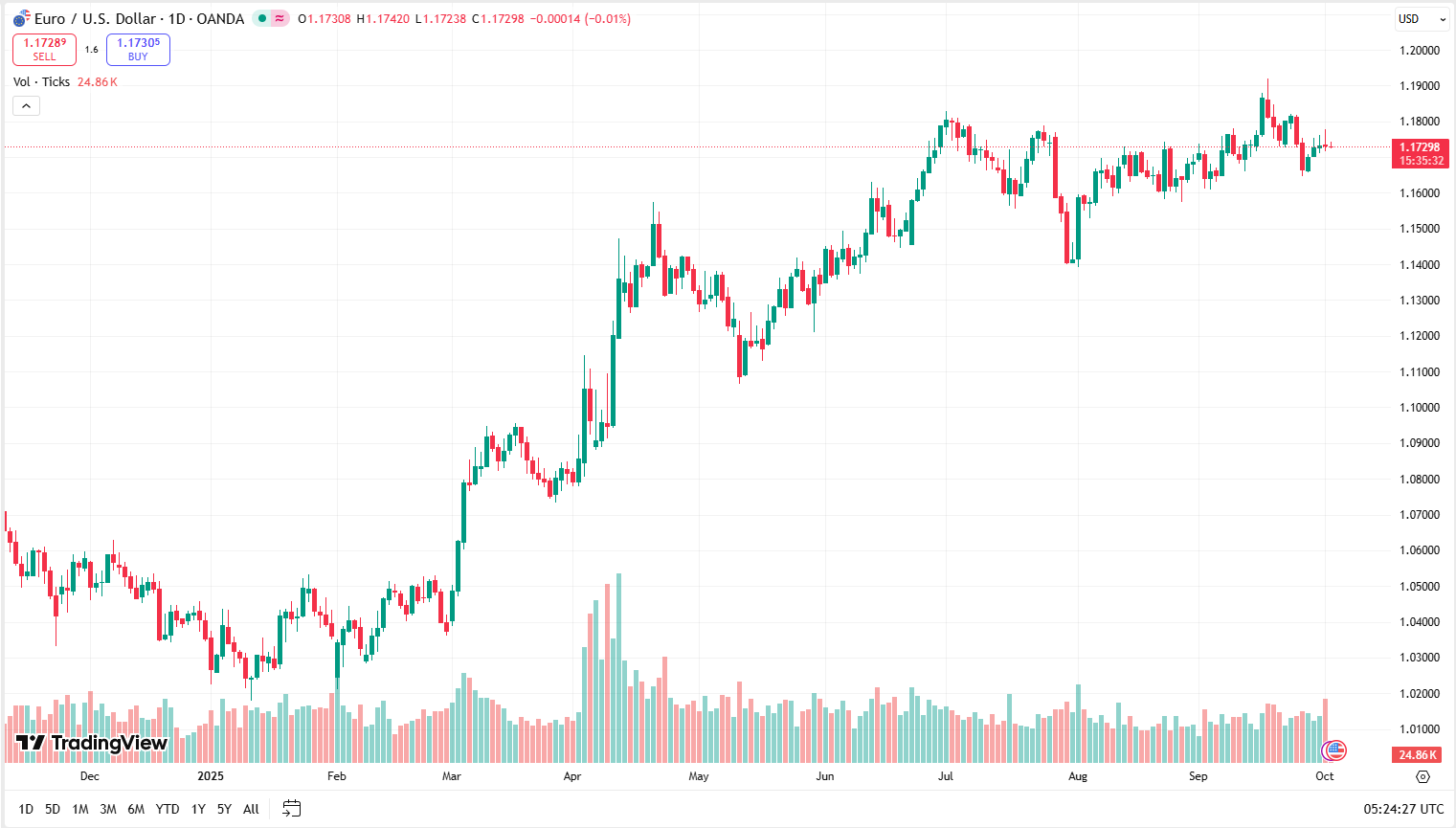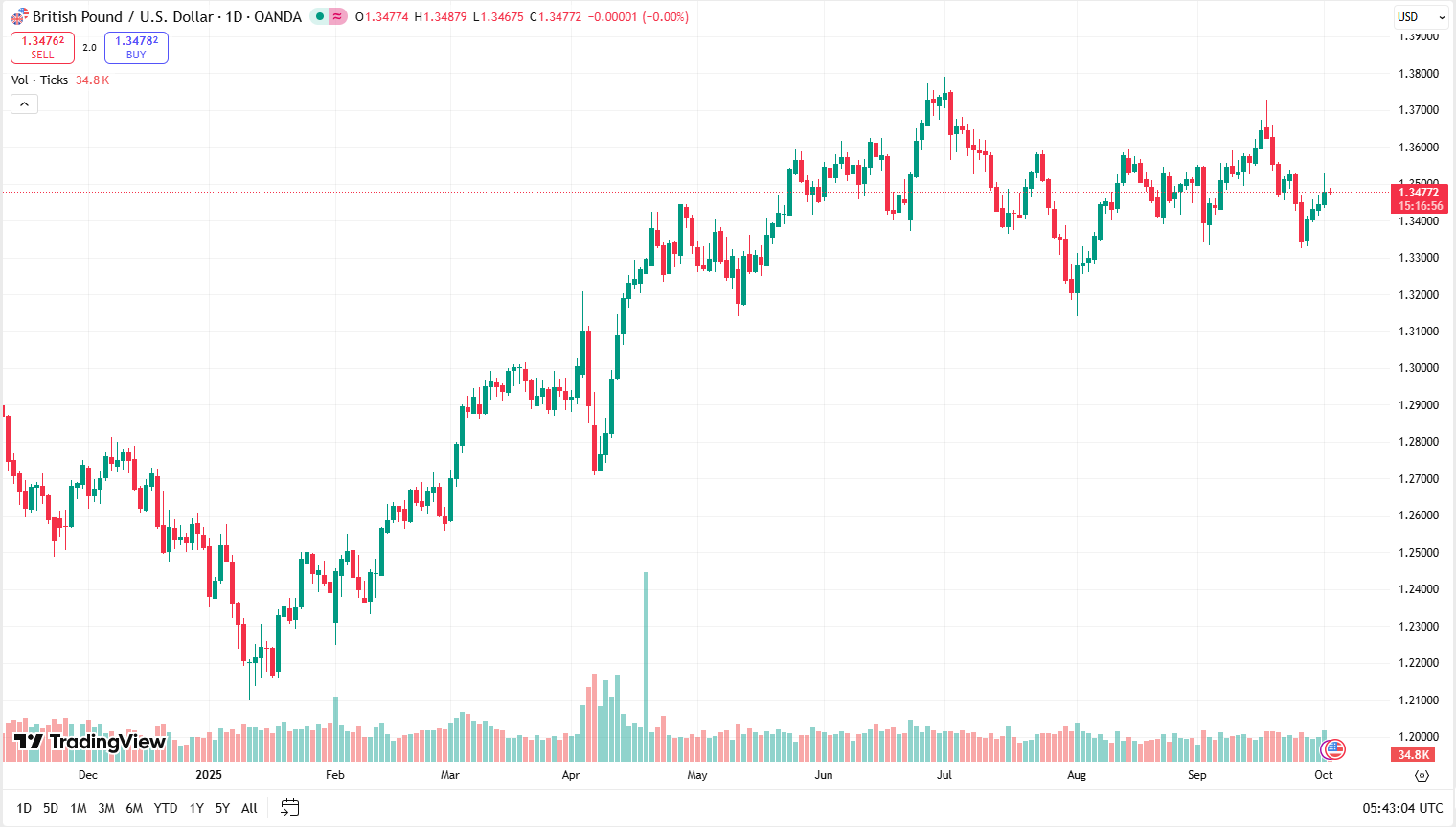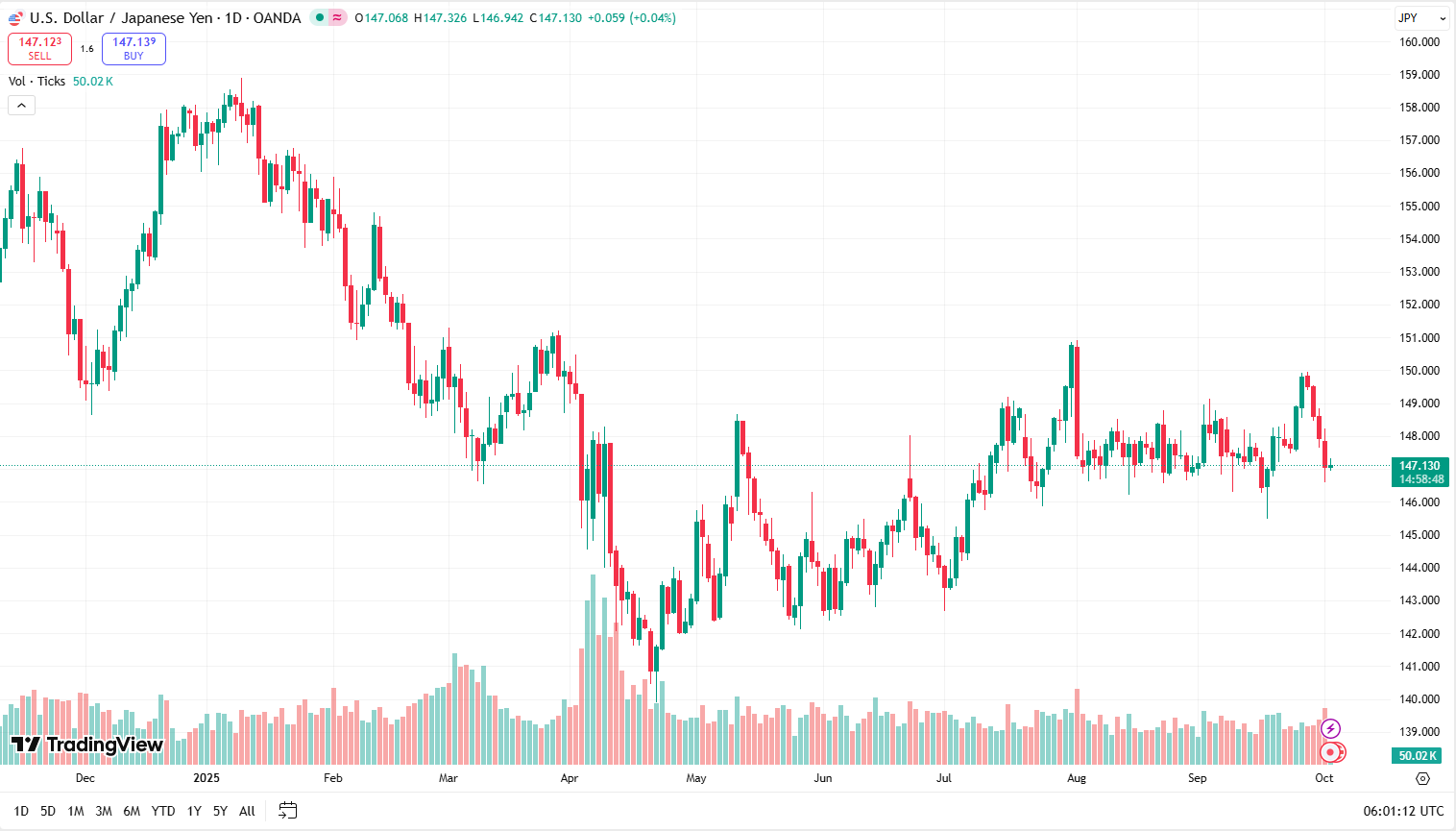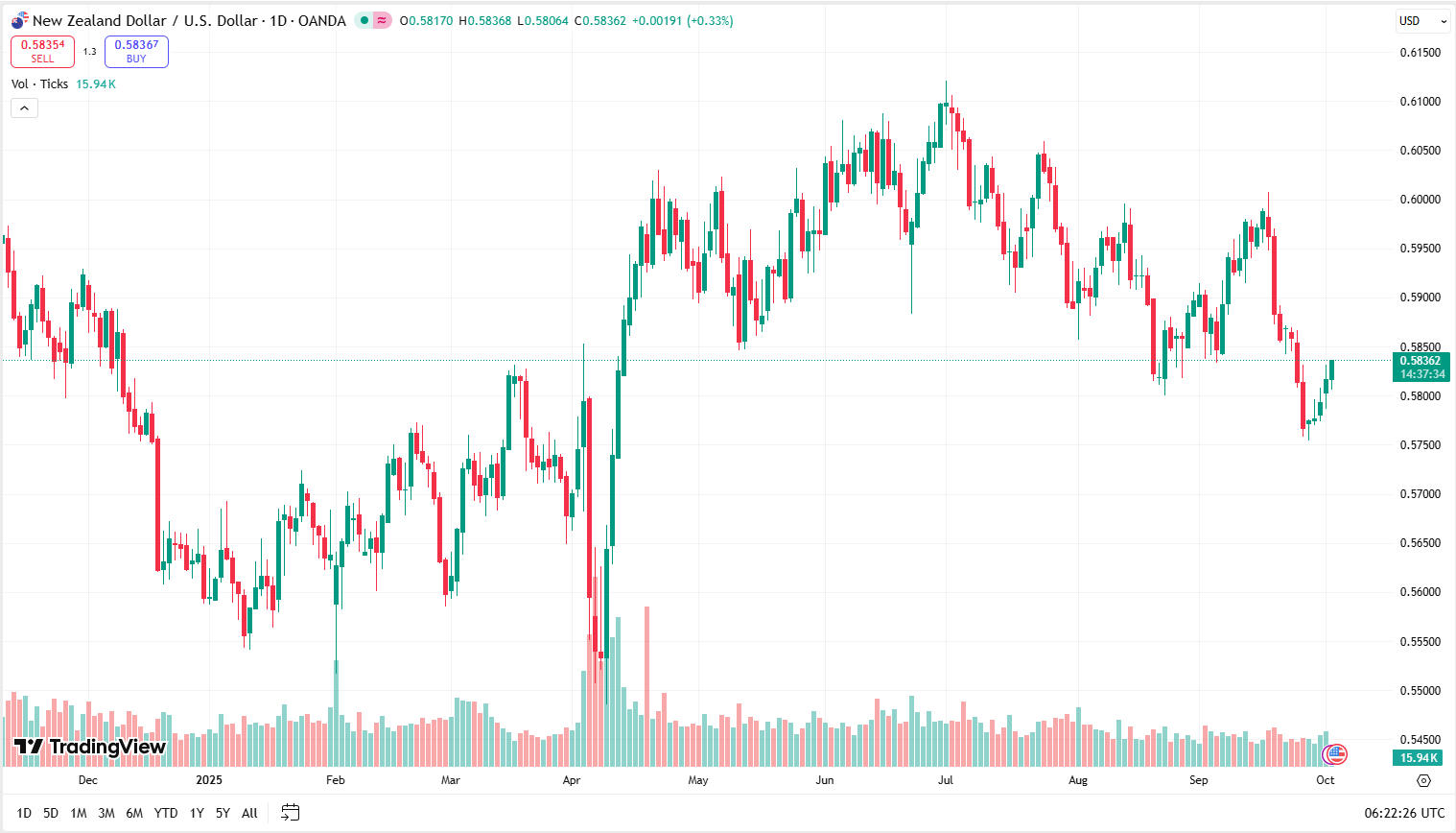EUR/USD Gains Ground Amid Political Uncertainty
The EUR/USD pair advanced modestly and traded near 1.1735 in Thursday’s Asian trading hours, as renewed pressure on the US. The US dollar is thought to have been a drag on sentiment. The partial US government shut down that started Wednesday after a congressional funding stalemate has increased investor insecurity. Market commentators point out that the disruption will put on hold the release of several major economic data, such as the weekly Initial Jobless Claims, as well as the September employment report, and decrease near-term transparency regarding the future of the U.S. labour market.
Market observers note that the greenback has been further burdened by political events, as the Trump administration said it would freeze up to $26 billion of money going to Democratic-leaning states. The action escalated the worries about policy stalemate and financial strains, negating the need of the US dollar as a safe-haven currency. Meanwhile, markets are growing confident that the Federal Reserve (Fed) will reduce interest rates by another 25 basis points by the time its October meeting arrives. Market reports point out that Fed funds futures are currently pricing in a high likelihood of easing, up from 96.2% a day ago, which supports the expectations of a softer policy stance.
Market reports indicate that the move by the US Supreme Court to pause its decision on the bid by President Trump to remove the Fed Governor, Lisa Cook to push the issue of central bank independence slightly in favour of the dollar medium term. Nevertheless, in the short-run, the risks remain skewed to the downside due to lack of strong economic statistics and political uncertainties. ECB President Lagarde indicated a contained inflation risk in Europe and that there is no urgency to make any cuts, which would support the euro, and not the US dollar.Analysts suggest that in the near future, the absence of high-frequency US releases because of the shutdown will expose the US dollar to the wider risk sentiment and political headlines. As long as EUR/USD is above 1.1700, the short-term trend supports a weak euro. Market commentators indicate that the US political uncertainty and global expansion risks could contain the upside potential, and even medium-term direction data-dependent after normal economic reporting returns.

GBP/USD Extends Rally as BoE Signals Caution
The GBP/USD pair extended its winning streak into a fifth straight session and traded around 1.348 in Thursday’s Asian hours. It is believed that the recent positive trend in Sterling has been supported by guarded remarks by Bank of England (BoE) officials, who emphasized that inflationary pressure is here to stay. The pair has been solidifying profits above the 1.3450 area, and the close-term resistance is observed nearer to 1.3500, whereas support is at 1.3400.
Market reports point out that the Bank of England (BoE) policymaker Catherine Mann on Wednesday repeated that the risk of higher-for-longer inflation was becoming real, indicating little room to ease policy in the short term. Similarly, Clare Lombardelli, the Deputy Governor has indicated that the shock of inflation cannot be discounted and price pressures may be here to stay longer than anticipated. These observations strengthened an account that the BoE will not turn to a rate cut soon, which will favour GBP in the short term.
Market reports point out that on the US side, the dollar has suffered due to the government shutdown after Congress could not reach a deal to get funding. Key data releases have also been delayed because the September Nonfarm Payrolls (NFP) report has been cancelled after the Labour Department shut down most operations. The absence of data on high-frequency labour markets undermines the short-term performance of the US dollar as investors lose a major indicator of economic momentum. Conversely, the ADP Employment Change report on Wednesday reported that private sector payrolls declined by 32,000 in September, nearly half what was expected, and contributed to labour market weakness.
Analysts anticipate that for the short-term the GBP/USD could remain underpinned by relative policy divergence and a weaker US data environment. Nonetheless, there are medium-term risks, as the continued fragility of the US economic activity may change the overall disposition to risk aversion, which tends to favour the safe-haven dollar. The traders are set to keenly observe other US data release and central bank communication to provide further guidance. Although short-term momentum is in favour of sterling, the risk balance implies that the duo might consolidate should market sentiment become defensive. In such a scenario, the GBP/USD exchange rate would remain sensitive to shifts in risk appetite.

USD/JPY Edges Lower Amid Diverging Policy Outlook
USD/JPY traded just around 147.00 level in Thursday’s Asian session, with price action reflecting a cautious tone amid diverging monetary policy expectations between the Federal Reserve (Fed) and the Bank of Japan (BoJ). The pair is believed to have slipped down after poking below the 147.00 handle overnight with markets becoming increasingly pricing in the possibility of a BoJ rate increase in October. This solidifies the tightening US-Japan yield spread, which still provides medium term support to the yen even though it has been weak lately.
Analysts indicate that market sentiment has been conditioned by two opposing forces: a subdued response to the potential US government shutdown, keeping a positive tone in the risk scene and the expectations of the policy direction of the Fed. The two additional Fed cuts that investors can expect this year limits the potential of the dollar to rise. This apprehensive background has limited the USD/JPY recovery to 153.91, and traders have seen any advance towards the 148.00 level as a sell into strength and not turning point.
Technically, the decisive fall below 147.00 is an indicator of downside momentum, where daily oscillators are inclined to the negative. The 100-day SMA coincides with the 146.50-146.00 area where immediate support can be expected. The analysts note that a persistent decline would reveal the September lows around 145.50, and may also reveal the 145.00 psychological level. Resistance on topside has changed to 147.30, with additional barriers at 148.00 and 200-day SMA at 148.35. The opening up of a rebounding zone of 149.00 would only be caused by a firm that would open just above that zone.
Market commentators point out that the future focus will be placed on future U.S economic data releases, weekly jobless claims and weekly ISM services numbers will focus more on Fed policy. Any indication of deteriorated labour market conditions or less vigorous services activity may strengthen anticipations of rate cuts, burdening the attractiveness of the dollar. Although the immediate risks continue to favour the downside of USD/JPY, traders need to monitor the changes in the US macro data, which may see the pair continue to fall or start levelling off above the vital support areas.

NZD/USD Extends Rebound Amid Dollar Weakness Concerns
The NZD/USD pair traded around 0.5825–0.5830 in Thursday’s Asian session, extending its rebound for a fifth straight day after finding dip-buying interest near the 0.5800 psychological mark. It is believed that the pair has recovered steadily from last week’s lows, the weakest level since April 10, supported by renewed demand for risk-sensitive assets and persistent weakness in the US dollar. However, traders remain cautious ahead of key U.S. economic developments that could steer near-term price momentum.
Market reports point out that the US Dollar Index (DXY) remains under pressure despite a modest overnight bounce, as expectations of further Federal Reserve (Fed) rate cuts continue to weigh. Market bets were reinforced after Wednesday’s ADP private-sector employment report revealed a surprise 32K job loss in September, the steepest decline since March 2023, alongside downward revisions to August figures. These signs of a weakening US labour market offset a slight improvement in ISM manufacturing PMI data, leaving the dollar vulnerable.
Market commentators point out that broader market sentiment also tilts against the greenback, with investors relatively unconcerned about a partial US government shutdown and equity markets maintaining a positive tone. This backdrop has favoured commodity-linked currencies such as the New Zealand dollar. Still, rising expectations that the Reserve Bank of New Zealand (RBNZ) could deliver additional rate cuts limit upside potential, creating a tug-of-war between short-term dollar weakness and medium-term Kiwi policy risks.
Analysts indicate that in the short term, traders will watch whether NZD/USD can secure a decisive break above the 200-day Simple Moving Average (SMA), currently near 0.5840, to confirm a sustained bottoming pattern. Near-term direction may hinge on US data releases, though weekly Initial Jobless Claims could face delays due to the government shutdown. In this environment, Fed officials’ speeches may act as the primary catalyst for volatility. While near-term momentum favours NZD/USD gains, medium-term risks tied to RBNZ policy easing and broader US dollar sentiment suggest a cautious outlook.



 English
English 



































































































